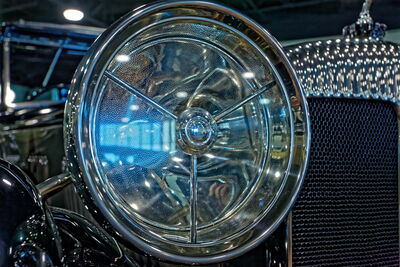B-29 Superfortress "Doc"
Aug 10, 2018 21:28:04 #
The Boeing B-29 Superfortress is a four-engine propeller-driven heavy bomber designed by Boeing, and flown primarily by the United States during World War II and the Korean War. Including design and production at over $3 billion, the B-29 was the single most expensive weapons project undertaken by the United States in World War II, exceeding the cost of the Manhattan Project by more than $1 billion.
B-29 Superfortress by Paul Sager, on Flickr
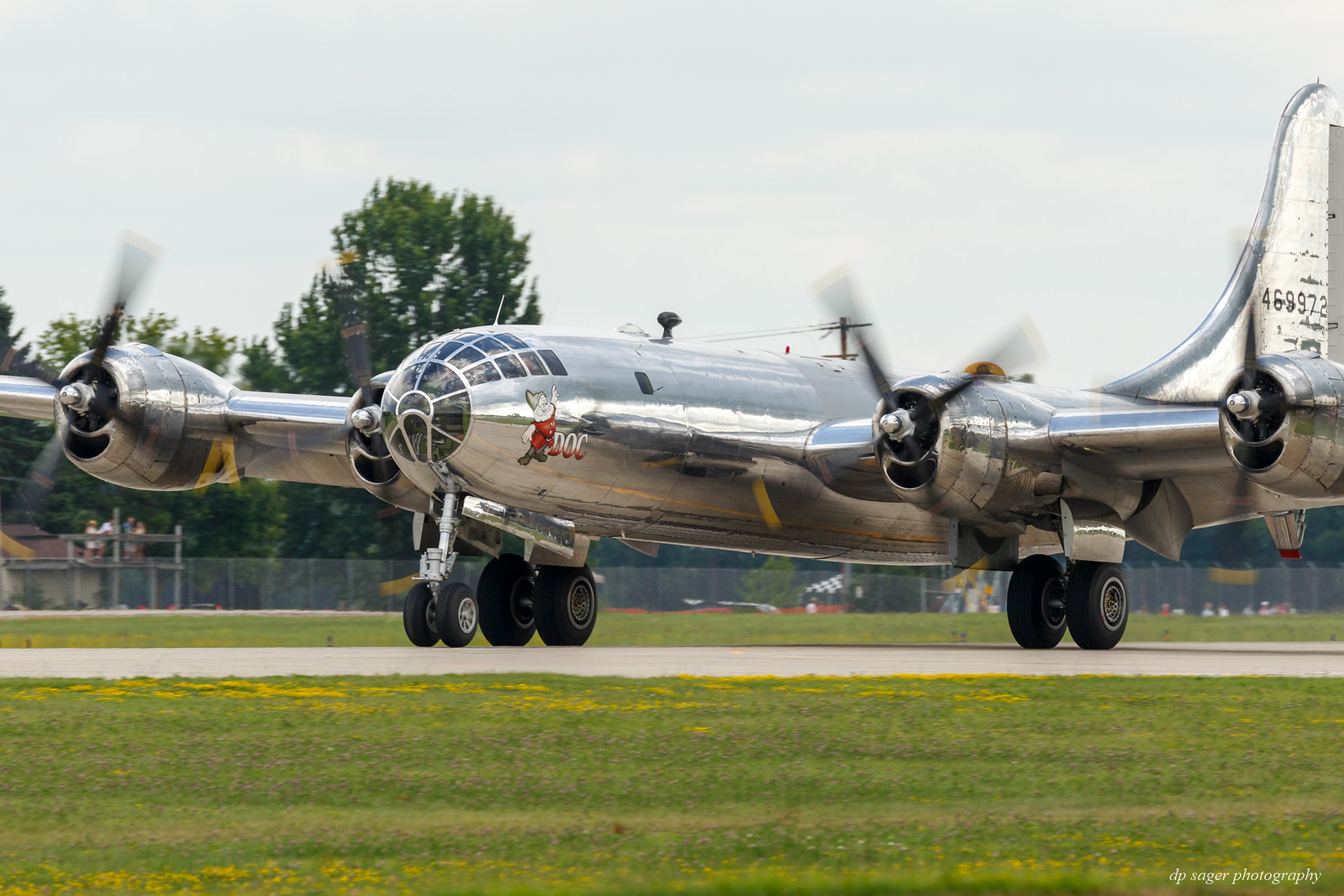
Because of the B-29's advanced design, unlike many other World War II-era bombers, the Superfortress remained in service long after the war ended, with a few even being employed as flying television transmitters for the Stratovision company in the late 1940s. Variants of the original B-29 remained in active service until the mid 1960s.
B-29 Superfortress
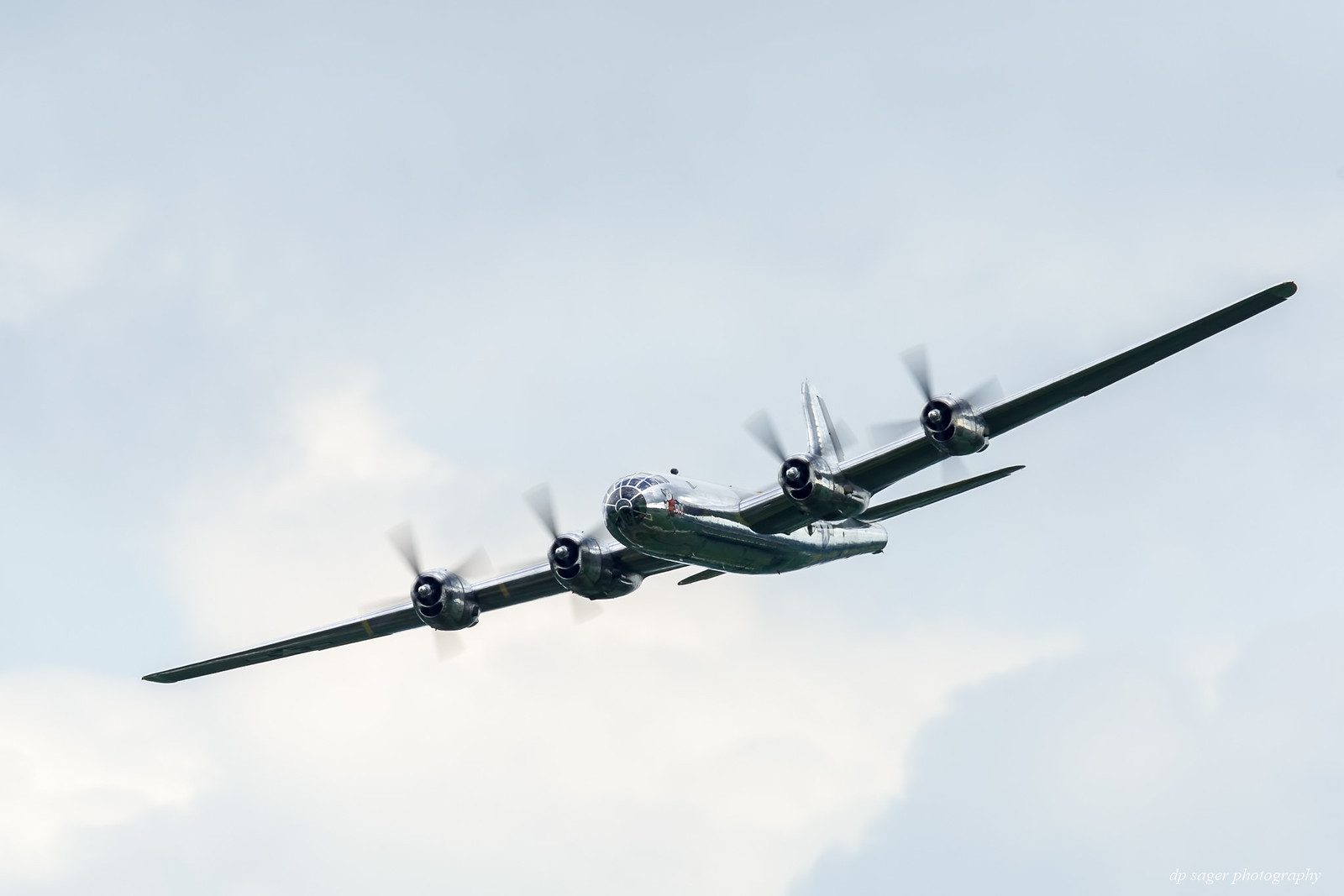
The B-29 production total was 3,970 aircraft. Dozens of B-29s remain as static displays, but only two examples, Fifi and Doc, have been restored to flying status, with Doc flying again for the first time from McConnell AFB on July 17, 2016.
B-29 Superfortress
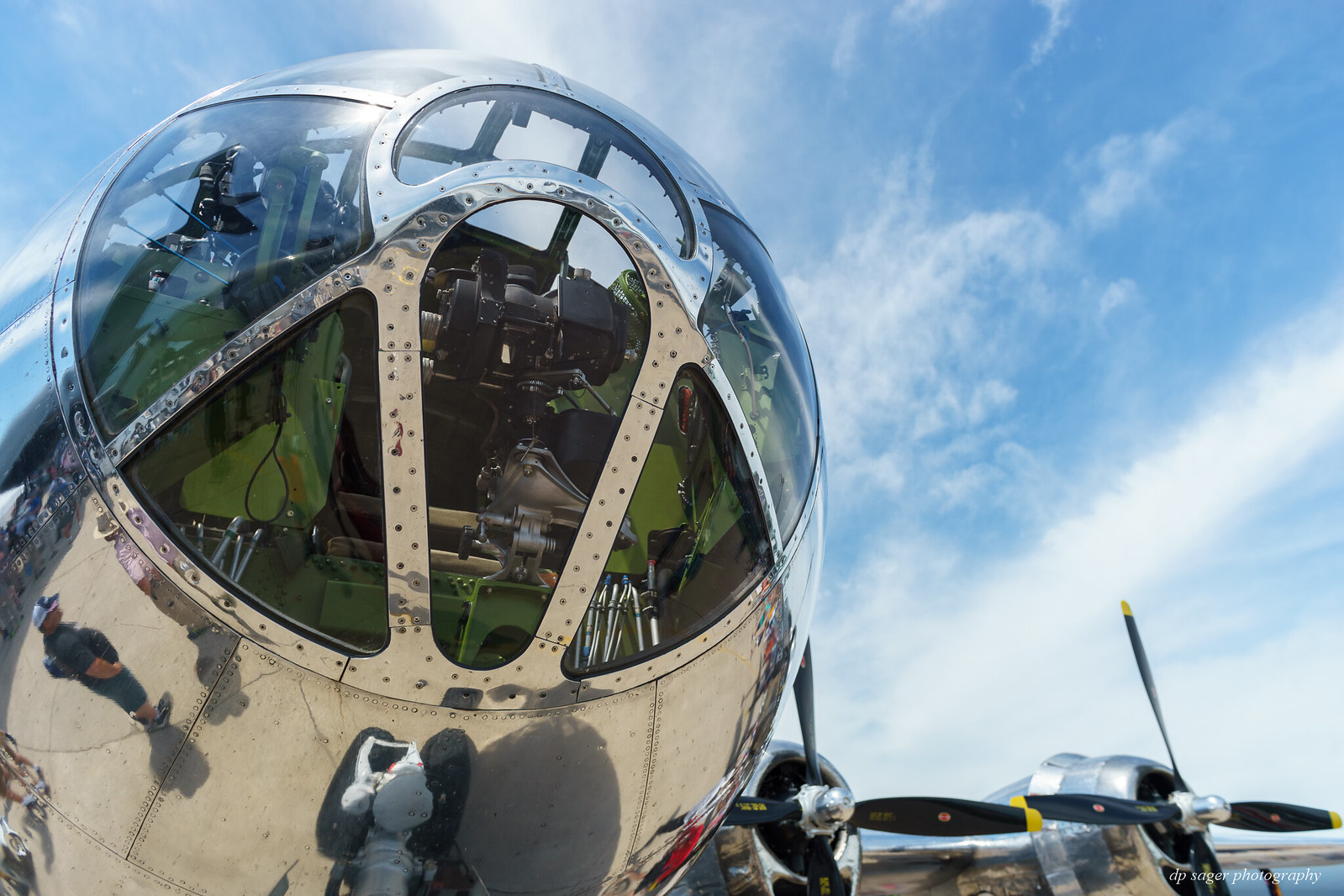
Innovations introduced by the B-29 included a pressurized cabin, dual-wheeled, tricycle landing gear, and an analog computer-controlled fire-control system directing four remote machine gun turrets that could be operated by a single gunner and a fire-control officer.
B-29 Superfortress
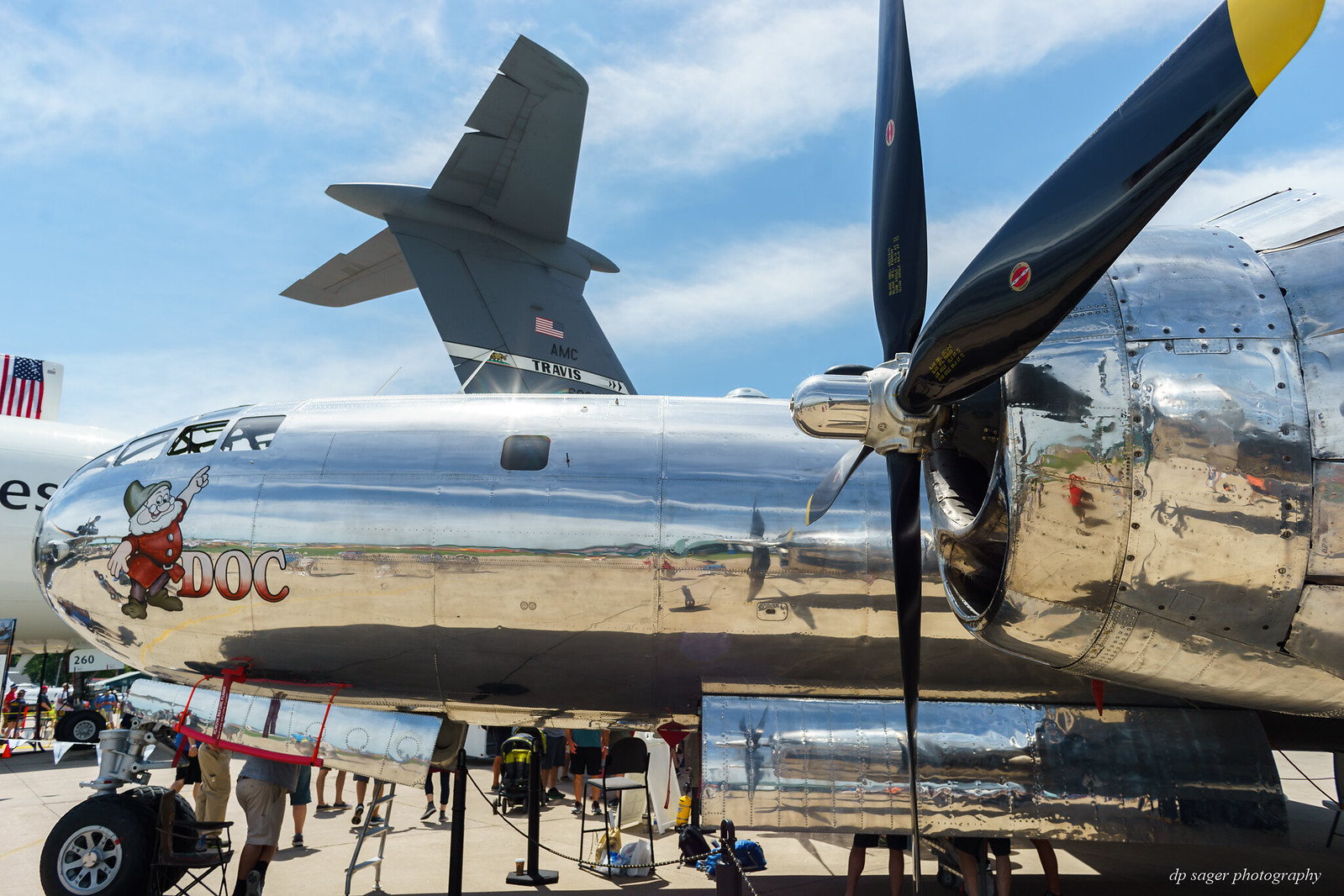
Production of the B-29 was phased out after World War II with the last example completed by Boeing's Renton factory on 28 May 1946. Many aircraft went into storage, being declared excess inventory and were ultimately scrapped as surplus. Others remained in the active inventory and equipped the Strategic Air Command when it formed on 21 March 1946. Twenty-two B-29s are preserved at various museums worldwide, including two flying examples; FIFI, which belongs to the Commemorative Air Force, and Doc, which belongs to Doc's Friends. Doc made its first flight in 60 years from Wichita, Kansas, on 17 July 2016. There are also four complete airframes either in storage or under restoration.
Doc landing at Oshkosh

In July of 1951, Doc was assigned to radar calibration duty, along with a few other B-29s. The squadron was known as the Seven Dwarfs. In May of 1955, Doc was assigned to target-towing duty and in March a year later, Doc and the rest of its squadron became targets for bomb training at China Lake, California.
For 42 years, Doc sat in the Mojave Desert serving as a target for the U.S. Navy. Beginning in 1987, plans started to remove and eventually restore the B-29 to flying status. It would take another 12 years to take possession of the airplane from the U.S. government.
B-29 Superfortress
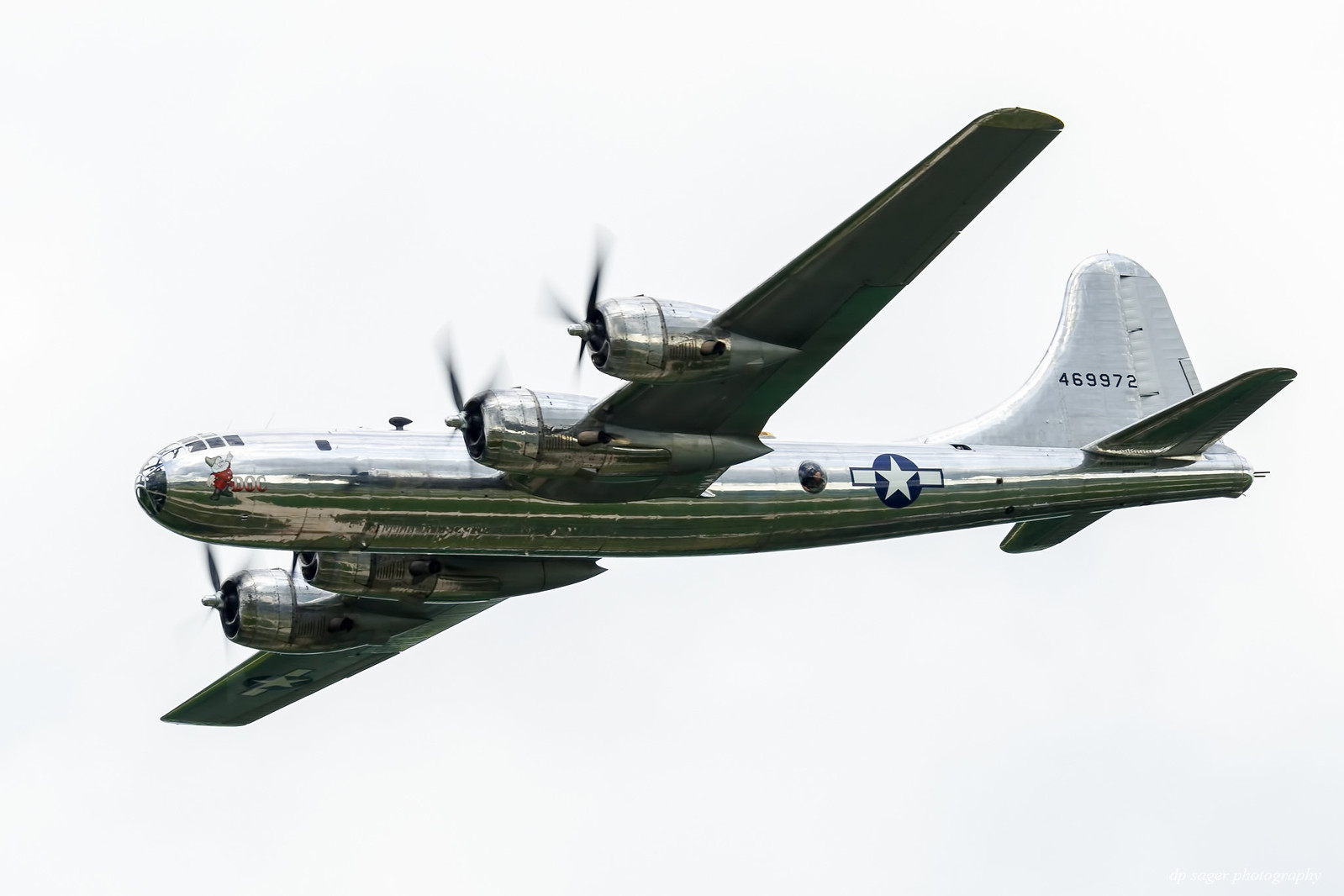
In 2013, a group of Wichita aviation enthusiasts & business leaders formed Doc’s Friends, a 501c3 non-profit, to manage the restoration project and help see it through to completion. Over the next 15 years, hundreds of volunteers have worked on Doc and the restoration project. Skilled workers and retirees from Boeing and Spirit AeroSystems, veterans, active duty military and others wanting to honor those who served, have spent tens of thousands of hours on Doc’s restoration. Countless individuals and organizations also made financial and in-kind contributions to keep the project going. https://www.b29doc.com/
The images are sized to fill your wide-screen display. Try using <F11> to maximize your browser window for the full effect. If the images overshoot your display, such as a laptop, just click on the image or the URL link and they'll resize to your screen from the host Flickr site. You can click a bit further into the image details on the Flickr page, if desired. EXIF data is available from the host Flickr pages as well. On the Flickr site, use your <L>key for Large and the <F11> for the full-screen.
B-29 Superfortress by Paul Sager, on Flickr

Because of the B-29's advanced design, unlike many other World War II-era bombers, the Superfortress remained in service long after the war ended, with a few even being employed as flying television transmitters for the Stratovision company in the late 1940s. Variants of the original B-29 remained in active service until the mid 1960s.
B-29 Superfortress

The B-29 production total was 3,970 aircraft. Dozens of B-29s remain as static displays, but only two examples, Fifi and Doc, have been restored to flying status, with Doc flying again for the first time from McConnell AFB on July 17, 2016.
B-29 Superfortress

Innovations introduced by the B-29 included a pressurized cabin, dual-wheeled, tricycle landing gear, and an analog computer-controlled fire-control system directing four remote machine gun turrets that could be operated by a single gunner and a fire-control officer.
B-29 Superfortress

Production of the B-29 was phased out after World War II with the last example completed by Boeing's Renton factory on 28 May 1946. Many aircraft went into storage, being declared excess inventory and were ultimately scrapped as surplus. Others remained in the active inventory and equipped the Strategic Air Command when it formed on 21 March 1946. Twenty-two B-29s are preserved at various museums worldwide, including two flying examples; FIFI, which belongs to the Commemorative Air Force, and Doc, which belongs to Doc's Friends. Doc made its first flight in 60 years from Wichita, Kansas, on 17 July 2016. There are also four complete airframes either in storage or under restoration.
Doc landing at Oshkosh

In July of 1951, Doc was assigned to radar calibration duty, along with a few other B-29s. The squadron was known as the Seven Dwarfs. In May of 1955, Doc was assigned to target-towing duty and in March a year later, Doc and the rest of its squadron became targets for bomb training at China Lake, California.
For 42 years, Doc sat in the Mojave Desert serving as a target for the U.S. Navy. Beginning in 1987, plans started to remove and eventually restore the B-29 to flying status. It would take another 12 years to take possession of the airplane from the U.S. government.
B-29 Superfortress

In 2013, a group of Wichita aviation enthusiasts & business leaders formed Doc’s Friends, a 501c3 non-profit, to manage the restoration project and help see it through to completion. Over the next 15 years, hundreds of volunteers have worked on Doc and the restoration project. Skilled workers and retirees from Boeing and Spirit AeroSystems, veterans, active duty military and others wanting to honor those who served, have spent tens of thousands of hours on Doc’s restoration. Countless individuals and organizations also made financial and in-kind contributions to keep the project going. https://www.b29doc.com/
The images are sized to fill your wide-screen display. Try using <F11> to maximize your browser window for the full effect. If the images overshoot your display, such as a laptop, just click on the image or the URL link and they'll resize to your screen from the host Flickr site. You can click a bit further into the image details on the Flickr page, if desired. EXIF data is available from the host Flickr pages as well. On the Flickr site, use your <L>key for Large and the <F11> for the full-screen.
Aug 10, 2018 21:53:12 #
Aug 10, 2018 22:39:36 #
Thanks so much for posting these pictures and the history. As a Cub Scout in the late forties, my den was lucky enough to be taken on a tour of a B-29 at Randolph AFB, San Antonio. I still remember riding the "trolley" through the tube (communication tunnel) over the bomb bays. Seeing and hearing these big prop-driven aircraft still gives me chills!
Aug 10, 2018 22:49:44 #
Aug 11, 2018 00:18:29 #
James56 wrote:
Great facts, great photography...well done Paul.
Thank you James! The best story I heard talking to the team handling Doc was the difficulty they had in getting the government to give up a derelict aircraft out in the desert. You wonder sometimes what people (bureaucracy) are thinking.
Aug 11, 2018 00:20:29 #
oldart wrote:
Thanks so much for posting these pictures and the history. As a Cub Scout in the late forties, my den was lucky enough to be taken on a tour of a B-29 at Randolph AFB, San Antonio. I still remember riding the "trolley" through the tube (communication tunnel) over the bomb bays. Seeing and hearing these big prop-driven aircraft still gives me chills!
Thank you oldart! I didn't do the tour of this plane and read about the tube later, during research, installed so the entire plane didn't need to be pressurized.
Aug 11, 2018 00:20:41 #
ken_stern wrote:
OUTSTANDING
THANKS
THANKS
Thank you very much Ken, glad you enjoyed!
Aug 11, 2018 06:53:20 #
CHG_CANON wrote:
The Boeing B-29 Superfortress is a four-engine pro... (show quote)
Great looking photos, Paul!
Aug 11, 2018 07:38:49 #
CHG_CANON wrote:
The Boeing B-29 Superfortress is a four-engine pro... (show quote)
I enjoyed the information and doc's shots, paul . excellent job.
Aug 11, 2018 08:02:01 #
av8nbuff
Loc: Rock and Roll Capital, Cleveland, Ohio
This project was undertaken by a group of dedicated aviation buffs led by Tony Mazzolini in Cleveland, Ohio. They formed the United States Aviation Museum with the thought of bringing Doc back to life. I was a member of that group and worked with Tony and others to secure the rights to Doc. You would not believe the amount of "red tape", rules and stipulations that had to be overcome by a group of U.S. taxpayers to obtain an obsolete aircraft that was paid for by the citizens of this country! We had to first obtain and restore to static (non flying) condition a B 25 Mitchel bomber; which was found in Venezuela, dismantled and shipped to us in 2 sea containers. It was then assembled and restored to the condition the U S Navy requested and is now on display at the Naval Museum in Pensacola, Florida. The rights to Doc were then obtained and the long journey to flying condition began. While I wish we could have succeeded in bringing Doc to Cleveland, it was a huge undertaking and I am glad that the folks at Wichita stepped in as well as many countless volunteers could finish the task that we had begun. Great pictures! I have few of the "before" condition that I will share with all soon.
Aug 11, 2018 08:15:19 #
Another excellent set of photos of our flying military heritage--nice work again, Paul. I have enjoyed seeing all of these.
Aug 11, 2018 09:20:45 #
Aug 11, 2018 09:45:10 #
Great shots; especially the first two. "FiFi" the other still-flying B-29 you mentioned was up here in New Hampshire a few weeks ago. As you can see, it's no where as shiny as "Doc" and it's obvious the cowl was hand-hammered into shape. They must have polished the hell out of Doc's aluminum to get it that reflective. For FiFi, they were selling a ride in the radio operator's seat for $500 and if you wanted the best view from the nose as the bombardier, it would set you back $1,600.00!
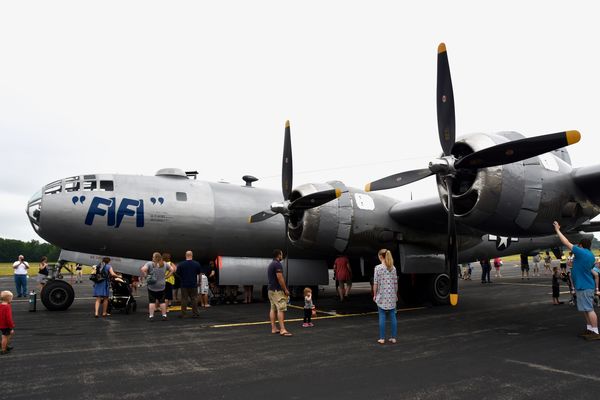
Aug 11, 2018 10:00:31 #
Aug 11, 2018 10:09:53 #
CHG_CANON wrote:
The Boeing B-29 Superfortress is a four-engine pro... (show quote)
Thank you for posting. And thanks to all for the information on these beautiful aircraft.
If you want to reply, then register here. Registration is free and your account is created instantly, so you can post right away.

